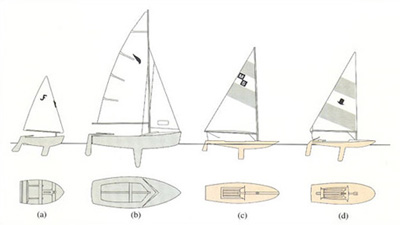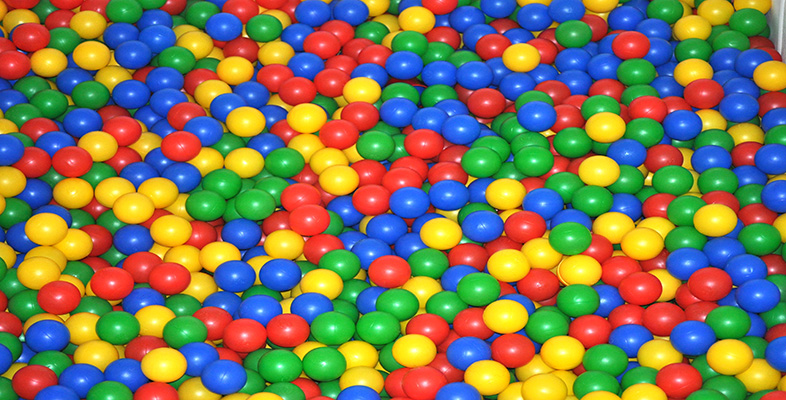6.4 Case history: the Topper boat
Replacement of one polymeric material by another may be undertaken entirely for manufacturing reasons, and this is what happened in the redesign of the Topper dinghy for thermoplastic polymer. The dinghy was originally designed for hand lay-up GRP in 1969 by Ian Proctor, a well known designer of small boats and yachts (Figure 61, Table 10). but sales had been restricted by the low output rates. The potential production rate if the boat could be injection moulded was very much greater, provided that a suitable thermoplastic could be found.

It was thought at the time of the design exercise in the late 1970s, that there was market demand for a small lightweight sailing boat which could be easily lifted on to a car roof-top for transport. Leisure activities had increased in the seventies, and the membership of sailing schools had increased during this period (Table 11). In addition, the existence of the GRP boat meant that there was already substantial experience of the craft in terms of its sailing characteristics, so that prototyping might not be necessary. There were clear cost savings to be made by jumping this step in the design sequence (Figure 60).
| Class | Designer | Overall length/m | Approx. sailing mass/kg | Sail area/m2 | Hull material | Crew |
|---|---|---|---|---|---|---|
| Jiffy | Ian Proctor | 2.29 | 36.2 | 3.34 | GRP | 1–2 |
| Optimist | Clark Mills | 2.31 | 35.0 | 3.25 | marine plywood | 1–2 |
| Durafloat | Colin Mudie | 2.29 | 27.2 | 3.25 | ABS (acrylonitrile-butadiene-styrene) plastic | 1–2 |
| Cadet | Jack Holt | 3.22 | 65.6 | 5.20 | GRP or marine plywood | 2 |
| Mirror | Jack Holt, Barry Bucknall | 3.30 | 61.3 | 6.41 | marine plywood | 1–2 |
| Gull | Ian Proctor | 3.35 | 93.0 | 6.50 | GRP or marine plywood | 1–3 |
| Moth | various | 3.35 | 65.6 | 6.26 | mainly GRP or marine plywood | 1 |
| Topper | Ian Proctor | 3.35 | 54.1 | 5.20 | GRP | 1–2 |
| Boat type | Number of craft | Share (%) |
|---|---|---|
| Sea yachts | 40 000 | 7 |
| Class sailboats | 148 000 | 24 |
| Small funboats | 235 000 | 39 |
| Open power craft | 120 000 | 20 |
| Motor cruisers | 67 000 | 10 |
| TOTALS | 610 000 | 100 |
In terms of physical properties alone, GRP is an excellent boat-building material because of its high stiffness and high specific strength. Chopped strand mat (CSM), where randomly oriented glass fibres ca. 5 cm long are embedded in a polyester matrix, is the normal form of GRP used for small boats; it possesses an average tensile modulus of 8500 MN m−2 and a tensile strength of about 170 MN m−2. One way of assessing the relative merit of different materials for a particular application is by calculating so-called merit indices. One of the simplest merit indices is for a tensile application, where the product is subjected to a pulling force along one axis, viz, a tensile force. In this case, the merit index is just

where E is the tensile modulus of the material, and ρ its density. The merit index, the specific stiffness, provides a measure of the mass of material required to achieve a given level of stiffness in a product. Such an index is clearly of interest to a designer when weight-saving is an important design criterion. Thus this index will be of great importance when a product is used primarily in tension, such as a rope or textile fibre which must be lifted or handled. Since CSM has a density of 1.5 Mg m−3, this gives a specific stiffness of 5.6 and specific strength of 0.11. Clearly, any material chosen to replace GRP should have a greater merit index.
A more important design criterion for small boat hulls is the flexural stiffness. It can be shown from simple beam theory that the specific flexural stiffness is E 1/3/ρ. Direct comparison of merit indices of different materials shows which represent the best value in terms of flexural stiffness per unit mass: materials with a high merit index are lighter than those with a low merit index for an identical stiffness in bending. Another common hull material is marine ply (E=6500 MN m−2, ρ= 0.5 Mg m−3) with a merit index of 65001/3/0.5 = 37.3. The merit index for GRP is 13.6, so that a GRP hull will be 37.3/13.6 or 2.75 times as heavy as a marine ply hull of the same flexibility. Unfortunately, marine ply cannot be shaped easily unless cut and bonded together. Monocoques of uniform structure are thus difficult, if not impossible, in marine ply.
It can also be shown that the hull thickness t is related to modulus by the expression

A marine ply hull will therefore be (8500/6500)1/3 or 1.09 times as thick as an equivalent GRP hull.
